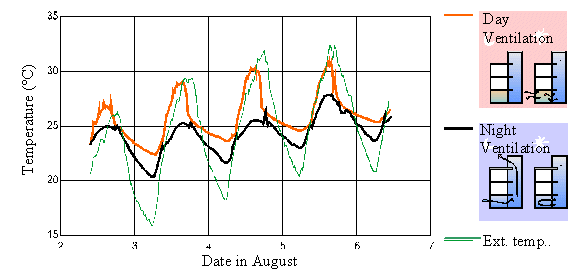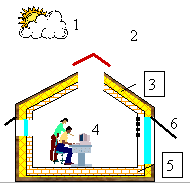 |
| Home |
HOPE: Health Optimisation Protocol for Energy-efficient Buildings |
|||||||||
|
|||||||||
| Guidelines | |
| Introduction Overall design Layout of occupied space Good air quality Lighting Protection against noise Energy and well-being Download Guidelines | |
Ensuring thermal comfort Thermal insulation
A good thermal insulation not only reduces heating and cooling energy use, but also improves comfort by reducing the unpleasant effects of cold or warm surfaces. In temperate climates, where buildings require essentially cooling, a good thermal insulation reduces the heat gains from outdoor air and solar radiation. However, it should be combined with passive cooling, to evacuate internal heat gains. HQ buildings are better insulated (lower U-values for roofs, walls and glazing) than other ones. Solar gains and solar protections
Solar energy enters freely in the building, mainly through the windows, thus contributing to heat the building. It should have large collecting areas on the sunny side of the building (from south-east to south-west in Northern hemisphere). Collecting areas are mostly windows, but can also be sunspaces or walls with transparent insulation. These windows should be equipped with mobile, controllable solar protections, in order to control the gains. Good solar protections for mid-season and summer are external, since only these can significantly reduce the gains to avoid overheating. Internal solar shading might be necessary to control lighting conditions (glare). In winter, internal shadings are preferred, since they avoid glare but allow solar heat gains. A large thermal mass (heavy construction) allows to store heat, thus avoiding overheating during sunny day and maintaining a mild indoor climate during the night.
Passive solar gains can be useful to improve comfort at low cost during the heating season, but may be uncomfortable when poorly controlled, especially in mid- or hot season. Passive cooling
Passive cooling through night-time ventilation is a comfortable, cheap, and energy-efficient way to keep the indoor environment within a comfortable temperature range in most European climates, in particular in central Europe, north, west and higher altitudes in Mediterranean areas. In well adapted buildings, it can ensure a comfortable indoor climate in summer without artificial cooling, provided that internal heat load is not too large.
Temperatures in two identical office rooms. One is aired as usual, only during the day. The other one is aired mainly at night. Thin line is outdoor temperature.
Principles of passive cooling are compatible with those of passive solar heating. As shown on Figure 4.7, they are:
Such a strategy can be applied only in climates where the daily average outdoor temperature is within comfort limits, and where there is a significant temperature swing between night and day. This is fortunately the case in most European climates. In addition to the heavy structure, the building should have large and well located openings, and these openings should be safe enough to remain open at night. |


